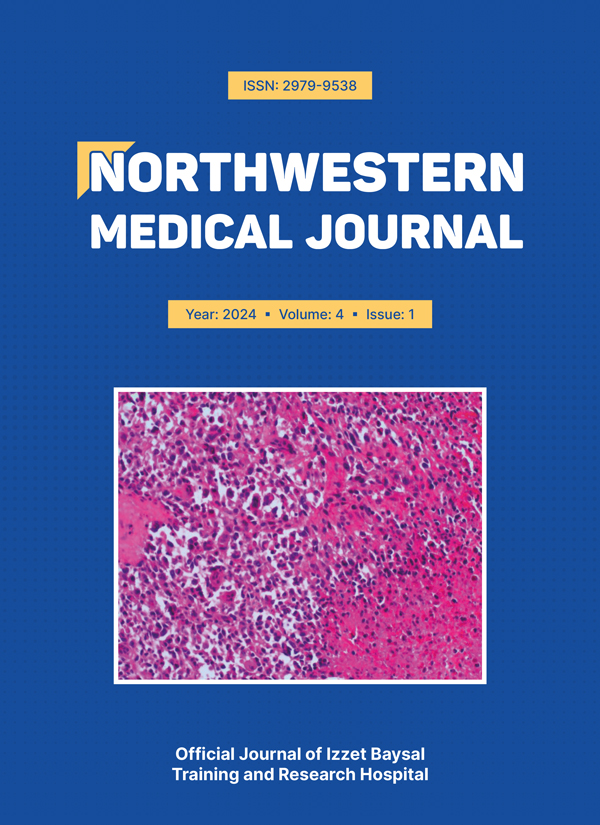Abstract
Aim: To investigate the clinical success of medical patent ductus arteriosus closure treatment for hemodynamically significant patent ductus arteriosus in term babies.
Methods: Our study included patients treated in two neonatal intensive care units with hemodynamically significant patent ductus arteriosus after the 3rd postnatal day and administered medical patent ductus arteriosus closure treatment (ibuprofen and paracetamol) at the discretion of the pediatric cardiologists while awaiting referral for surgical closure treatment.
Our retrospective analysis included anthropometric measurements at birth, the day treatment started postnatally, and other existing clinical conditions that might influence the prognosis of patent ductus arteriosus. Then, treatment success was evaluated by echocardiographic results.
Results: We included all ten patients diagnosed with hemodynamically significant patent ductus arteriosus and administered medical treatment with a mean gestational age at birth of 38.4 ± 1.21 weeks, and median birth weight of 3125 grams (3005-3200). We started medical closure treatment at mean postnatal 11.6 ± 4.9 days with ibuprofen (70%, n=7) or paracetamol (30%, n=3). 40% (n=4) of the infants had complete closure, 20% (n=2) became asymptomatic, and 10% (n=1) underwent surgical ligation. 30% (n=3) of patients died due to different complications during surgical preparation. As we defined treatment success as complete or partial closure and compared paracetamol and ibuprofen success, there was no statistically significant difference between them (p=0.5).
Conclusion: Medical closure treatment might be effective in the presence of hemodynamically significant patent ductus arteriosus in term infants. There was no statistical superiority of paracetamol or ibuprofen treatments over each other in terms of treatment success.
Keywords: newborn, patent ductus arteriosus, ibuprofen, paracetamol
Copyright and license
Copyright © 2024 The Author(s). This is an open-access article published by Bolu İzzet Baysal Training and Research Hospital under the terms of the Creative Commons Attribution License (CC BY) which permits unrestricted use, distribution, and reproduction in any medium or format, provided the original work is properly cited.
How to cite
References
- Anilkumar M. Patent ductus arteriosus. Cardiol Clin. 2013; 31(3): 417-30. https://doi.org/10.1016/j.ccl.2013.05.006
- Hung YC, Yeh JL, Hsu JH. Molecular Mechanisms for Regulating Postnatal Ductus Arteriosus Closure. Int J Mol Sci. 2018; 19(7): 1861. https://doi.org/10.3390/ijms19071861
- Yokoyama U, Minamisawa S, Ishikawa Y. Regulation of vascular tone and remodeling of the ductus arteriosus. J Smooth Muscle Res. 2010; 46(2): 77-87. https://doi.org/10.1540/jsmr.46.77
- Nguyen M, Camenisch T, Snouwaert JN, et al. The prostaglandin receptor EP4 triggers remodelling of the cardiovascular system at birth. Nature. 1997; 390(6655): 78-81. https://doi.org/10.1038/36342
- Köksal N, Aygün C, Uras N. Turkish Neonatal Society guideline on the management of patent ductus arteriosus in preterm infants. Turk Pediatri Ars. 2018; 53(Suppl 1): S76-S87. https://doi.org/10.5152/TurkPediatriArs.2018.01808
- Reller MD, Strickland MJ, Riehle-Colarusso T, Mahle WT, Correa A. Prevalence of congenital heart defects in metropolitan Atlanta, 1998-2005. J Pediatr. 2008; 153(6): 807-13. https://doi.org/10.1016/j.jpeds.2008.05.059
- Hoffman JI, Kaplan S. The incidence of congenital heart disease. J Am Coll Cardiol. 2002; 39(12): 1890-900. https://doi.org/10.1016/s0735-1097(02)01886-7
- Lewis TR, Shelton EL, Van Driest SL, Kannankeril PJ, Reese J. Genetics of the patent ductus arteriosus (PDA) and pharmacogenetics of PDA treatment. Semin Fetal Neonatal Med. 2018; 23(4): 232-8. https://doi.org/10.1016/j.siny.2018.02.006
- Hsu HW, Lin TY, Liu YC, Yeh JL, Hsu JH. Molecular Mechanisms Underlying Remodeling of Ductus Arteriosus: Looking beyond the Prostaglandin Pathway. Int J Mol Sci. 2021; 22(6): 3238. https://doi.org/10.3390/ijms22063238
- Feltes TF, Bacha E, Beekman RH, et al. Indications for cardiac catheterization and intervention in pediatric cardiac disease: a scientific statement from the American Heart Association. Circulation. 2011; 123(22): 2607-52. https://doi.org/10.1161/CIR.0b013e31821b1f10
- Hamrick SEG, Sallmon H, Rose AT, et al. Patent Ductus Arteriosus of the Preterm Infant. Pediatrics. 2020; 146(5): e20201209. https://doi.org/10.1542/peds.2020-1209
- Yantie NP, Djer MM, Suyatna FD, et al. Oral ibuprofen in full-term neonate's patent ductus arteriosus closure: Discerning the role of prostaglandin, vascular endothelial growth factor, and immature platelet fraction. Current Pediatric Research. 2017; 21(4): 526.
- Asadpour N, Malek-Ahmadi MR, Malekpour A, Bagheri N. The effect of oral ibuprofen on closure of patent ductus arteriosus in term neonates: A clinical trial study. Int J Pediatr. 2020; 8(9): 11901-9.
- Alipour MR, Mozaffari Shamsi M, Namayandeh SM, Pezeshkpour Z, Rezaeipour F, Sarebanhassanabadi M. The Effects of Oral Ibuprofen on Medicinal Closure of Patent Ductus Arteriosus in Full-Term Neonates in the Second Postnatal Week. Iran J Pediatr. 2016; 26(4): e5807. https://doi.org/10.5812/ijp.5807
- Backes CH, Kennedy KF, Locke M, et al. Transcatheter Occlusion of the Patent Ductus Arteriosus in 747 Infants <6 kg: Insights From the NCDR IMPACT Registry. JACC Cardiovasc Interv. 2017; 10(17): 1729-37. https://doi.org/10.1016/j.jcin.2017.05.018











